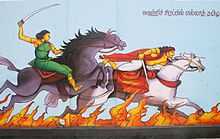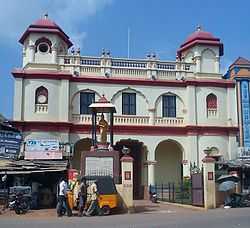Velu Nachiyar
| Rani Velu Nachiyar Rani | |
|---|---|
|
Queen of Sivagangai Princess of Ramanathapuram | |
|
Statue of Rani Velu Nachiyar at the historic palace and her residence, Sivagangai | |
| Reign | c. 1760-c. 1790 |
| Successor | British Rule |
| Father | Chellamuthu Sethupathy |
| Mother | Muthathal Nachiyar |
| Born |
3 January 17301 Sivaganga, Tamil Nadu, India |
| Died |
c. 1790 Sivaganga, Tamil Nadu, India |
| Religion | Hinduism |
Rani Velu Nachiyar (Tamil: இராணி வேலு நாச்சியார்) was an 18th-century Indian queen from Sivaganga. Rani Velu Nachiyar was the first queen to fight against the British in India, even preceding the famous Rani Laxmibai of Jhansi.[1]
Her life

She was the princess of Ramanathapuram and the daughter of Chellamuthu Sethupathy. She married the king of Siva Gangai and they had a daughter - Vellachi Nachiar. When her husband Muthuvaduganathaperiya Udaiyathevar was killed, she was drawn into battle. Her husband and his second wife were killed by a few British soldiers and the son of the Nawab of Arcot. She escaped with her daughter, lived under the protection of Hyder Ali at Virupachi near Dindigul for eight years.[2] During this period she formed an army and sought an alliance with Gopala Nayaker and Hyder Ali with the aim of attacking the British. In 1780 Rani Velu Nachiyar fought the British and won the battle. When Velu Nachiyar finds the place where the British stock their ammunition, she builds the first human bomb. A faithful follower, Kuyili douses herself in oil, lights herself and walks into the storehouse.[3] Rani Velu Nachiyar formed a woman's army named “udaiyaal” in honour of her adopted daughter — Udaiyaal, who died detonating a British arsenal. Nachiar was one of the few rulers who regained her kingdom and ruled it for 10 more years.[4]
Velu Nachiyar is the first queen who fought for the freedom against British in India and gave them a free run for their life. The first revolutionary who opposed the rule of British in Tamil Nadu even before the Sepoy mutiny which is considered as the first war against the British rule in India. The Queen Velu Nachiar granted powers to Marudu brothers to administer the country in 1780. Velu Nachiar died a few years later, but the exact date of her death is not known (it was about 1790). Marudu brothers are the sons of Udayar Servai alias Mookiah Palaniappan Servai and Anandayer alias Ponnathal.[5]
On 31-December-2008, a commemorative postage stamp on her was released.[6]
References
- ↑ The Hindu - 10-Aug-2010
- ↑ "Uphill, for history’s sake". The Hindu (India). 24 December 2007.
- ↑ "Of woman power and Tamizh glory". IBN Live (Chennai, India). 14 June 2011.
- ↑ The Hindu - 14-Aug-2010
- ↑ "History-Sivaganga district". Sivaganga dist. - Tamilnadu govt., India. Retrieved 24 November 2011.
- ↑ "India Post - Stamps 2008". Postal department, Government of India.
See also
- Maruthu Pandiyar
- Indian independence movement
- Indian independence activists
